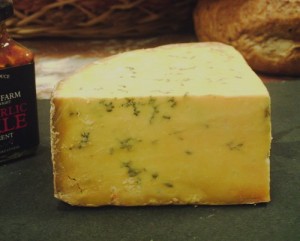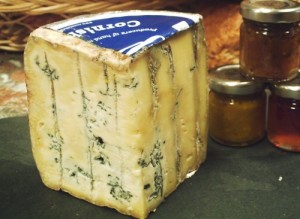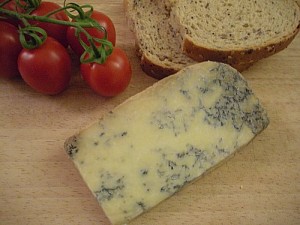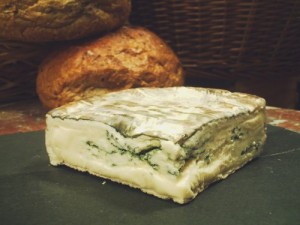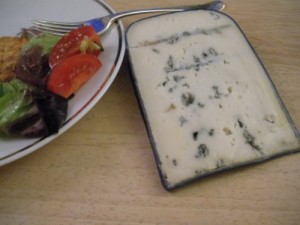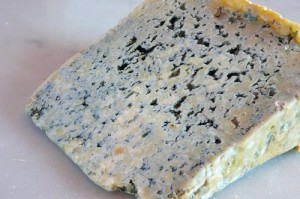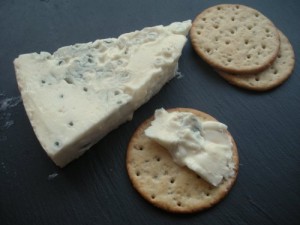Archive for the ‘Blue’ Category
Shropshire Blue
April 2nd, 2013 Posted 4:52 pm
| Despite its name, Shropshire Blue was invented in Inverness, and according to our sources, no Shropshire Blue is actually made in Shropshire. 8OColoured with annatto, this cheese has a wonderful golden orange colour with starkly contrasting blue/green veins.
It is based on the Stilton recipe and, other than its colour, is very similar in appearance and texture. Hard and crumbly with a gnarled greyish rind. The smell is similar too, though there are overtones of caramel. This characteristic also comes through in the flavour, which is again similar, but not as strong and acidic as Stilton. It has a very “blue” flavour, yet it is smooth and creamy with none of that aggressive Stilton “bite”. All in all a very pleasant cheese and well work seeking out. It’s not too difficult to find and can be found in some supermarkets. It keeps well, so the quality seems to be fairly consistent. |
Reviewed by Nick & Olympia 2010




 (4/5)
(4/5)
Posted in 4 Stars - Very Good, Blue, Cow's milk, English, Hard
Cornish Blue
February 17th, 2013 Posted 4:13 pm
| It looks like a blue cheese that would knock your socks off. A gnarled, rank looking grey/straw coloured rind hiding an equally, rank and “old” looking patchy cream, brown and blue pate. Strong looking blue moulds gather around the regular holes that have been punched through the cheese specifically for this purpose.
But, looks can be deceptive in the world of cheese, and this is definitely a case of don’t judge a book by its cliché. It is beautifully creamy, with a very mild Stilton like flavour. If Stilton had a soft southern cousin, this would be it. If, Stilton scares you because of its pungency or acidity, then this would make a good substitute. |
Purchased from Cheese Please, Lewes.
Reviewed by Nick & Olympia, 2011




 (3/5)
(3/5)
Posted in 3 Stars - Good, Blue, Cow's milk, English, Hard
Dorset Blue Vinny
June 17th, 2012 Posted 4:56 pm
| On the outside, its rind is grey and brown, with the rough, scarred texture of a comet beaten planet. This cheese is not immediately appealing, except, perhaps to the hardcore cheese fanatic.
On the inside, a smooth creamy paste attractively marbled with fine blue veining. This is a traditional Dorset recipe that has recently been revived. It starts off creamy with quite a strong blue flavour with a similar strength and body of a Danish blue, without the sharpness. Then it bites… and means it. The Cabrales like burn with a tart pepperyness attacks the back of the throat, leaving you grasping for that glass of wine… but BEWARE! this is not a match for a dry wine. The combination can be quite foul. Instead, a sweet wine or cider is recommended. A good strong blue cheese, but maybe not to everyone’s taste. It does however, make a superb blue cheese sauce, delicious with pasta. |
Purchased from Cheese Please, Lewes.
Reviewed by Nick & Olympia, 2012.




 (3/5)
(3/5)
Posted in 3 Stars - Good, Blue, Cow's milk, English, Hard
Cote Hill Blue
June 16th, 2012 Posted 5:52 pm
| This cheese can be a bit of a Jekyll and Hyde. When young, with it’s innocent, pure white rind, it is mild and creamy, but as it ages, it starts to turn to the dark side.
This is a semi-soft blue cow’s milk cheese, made in Lincolnshire. When in its young and innocent phase, It resembles a blue brie or Castello blue. Very mild and creamy, almost buttery, but possibly a little “raw”. However, as it ages, it develops a grey mould on its rind (pictured). This is the sign that it has learned to bite back. Initially, it remains similar to its earlier form, slightly stronger in flavour, but still mild and creamy… then it retaliates with a slight Cabrales like burn and bitter, lingering aftertaste. This is a cheese that changes character whilst it matures. It is therefore advisable to eat it when it is at the right level of maturity for your taste. |
Purchased from Cheese Please, Lewes.
Reviewed by Nick & Olympia.
Immature 



 (1/5)
(1/5)
Mature 



 (2.5/5)
(2.5/5)
Posted in 2 Stars - OK, Blue, Cow's milk, English, Semi-soft
Ribblesdale Blue Goat
May 27th, 2012 Posted 10:44 pm
| This Yorkshire made hard goat’s milk cheese, wrapped in its dark green wax coating, with brilliant white paste and dusty sage green veins, is immediately visually striking.
On first tasting, there is a subtle goatiness and a smooth creamy texture with the fresh flavour that some goat’s cheese have. As the goatiness quickly fades, it makes way for a distinct blueness, that is again subtle and delicate. Its complex mix and broad range of flavours are unusual but pleasing, as they do not compete but compliment one another in an extremely satisfying manner. Sat atop a Cornish Wafer and eaten with a glass of crisp white wine, this cheese is a truly delightful experience. UPDATE – Be aware! – This cheese is better when young. If it gets too old, it can turn to the dark side. It loses it’s beautiful subtleties, becomes extremely overpoweringly blue in flavour with the throat attacking Cabrales effect. |
Purchased from Cheese Please, Lewes.
Reviewed by Nick & Olympia 2012.




 (5/5)
(5/5)
Posted in 5 Stars - Excellent, Blue, English, Goat's milk, Hard
Cabrales
May 22nd, 2012 Posted 3:35 pm
| Cabrales is a Spanish blue cheese made primarily from cow’s milk but often with ewe and goat added.It has a grey/green colouration and a crumbly texture. It’s flavour, however, is a somewhat acquired taste.
This cheese should come with a warning. Tasting is not for the feint of heart. It starts off pleasant enough, it’s paste is initially creamy, but then something awful happens. The acrid taste hits you like you’re chewing on a wasp, sharp, acid, bitter. It instantly dries the mouth, turning it inside-out and making it difficult to swallow. Then it burns and burns… and then it burns some more. I can only liken it to licking the corroded contacts of leaky PP3 battery. Once swallowed, the bitter aftertaste lingers and it leaves you with a sore throat. This is the vindaloo of the cheese world. Used, I’m sure, by young, testosterone charged, Spanish men, as a post drinking session test of machismo. It is worth tasting, if only for the experience, but it is advisable to have a large glass of water close to hand. |
Tasted at La Fromagerie, London (no, we didn’t buy any)
Reviewed by Nick & Olympia 2010




 (0/5)
(0/5)
Posted in Blue, Cow's milk, Goat's milk, Sheep's milk, Spanish, Unusual cheese
Gorgonzola
May 7th, 2012 Posted 10:57 pm
Reviewed by Nick & Olympia
Dolce 



 (4/5)
(4/5)
Piccante 



 (3.5/5)
(3.5/5)
Stagionata 



 (5/5)
(5/5)
Posted in 3 Stars - Good, 4 Stars - Very Good, 5 Stars - Excellent, Blue, Cow's milk, Italian, Soft

